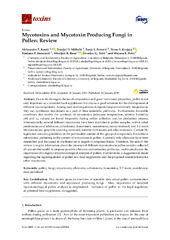Приказ основних података о документу
Mycotoxins and Mycotoxin Producing Fungi in Pollen: Review
| dc.creator | Kostić, Aleksandar | |
| dc.creator | Milincić, Danijel D. | |
| dc.creator | Petrović, Tanja | |
| dc.creator | Krnjaja, Vesna | |
| dc.creator | Stanojević, Sladjana | |
| dc.creator | Barać, Miroljub | |
| dc.creator | Tešić, Živoslav | |
| dc.creator | Pešić, Mirjana | |
| dc.date.accessioned | 2020-12-17T22:41:03Z | |
| dc.date.available | 2020-12-17T22:41:03Z | |
| dc.date.issued | 2019 | |
| dc.identifier.issn | 2072-6651 | |
| dc.identifier.uri | http://aspace.agrif.bg.ac.rs/handle/123456789/5115 | |
| dc.description.abstract | Due to its divergent chemical composition and good nutritional properties, pollen is not only important as a potential food supplement but also as a good substrate for the development of different microorganisms. Among such microorganisms, toxigenic fungi are extremely dangerous as they can synthesize mycotoxins as a part of their metabolic pathways. Furthermore, favorable conditions that enable the synthesis of mycotoxins (adequate temperature, relative humidity, pH, and a(w) values) are found frequently during pollen collection and/or production process. Internationally, several different mycotoxins have been identified in pollen samples, with a noted predominance of aflatoxins, ochratoxins, fumonisins, zearalenone, deoxynivalenol, and T-2 toxin. Mycotoxins are, generally speaking, extremely harmful for humans and other mammals. Current EU legislation contains guidelines on the permissible content of this group of compounds, but without information pertaining to the content of mycotoxins in pollen. Currently only aflatoxins have been researched and discussed in the literature in regard to proposed limits. Therefore, the aim of this review is to give information about the presence of different mycotoxins in pollen samples collected all around the world, to propose possible aflatoxin contamination pathways, and to emphasize the importance of a regular mycotoxicological analysis of pollen. Furthermore, a suggestion is made regarding the legal regulation of pollen as a food supplement and the proposed tolerable limits for other mycotoxins. | en |
| dc.publisher | MDPI, BASEL | |
| dc.relation | info:eu-repo/grantAgreement/MESTD/Technological Development (TD or TR)/31069/RS// | |
| dc.relation | info:eu-repo/grantAgreement/MESTD/Basic Research (BR or ON)/172017/RS// | |
| dc.relation | info:eu-repo/grantAgreement/MESTD/Integrated and Interdisciplinary Research (IIR or III)/46010/RS// | |
| dc.relation | info:eu-repo/grantAgreement/MESTD/Technological Development (TD or TR)/31023/RS// | |
| dc.rights | openAccess | |
| dc.rights.uri | https://creativecommons.org/licenses/by/4.0/ | |
| dc.source | Toxins | |
| dc.subject | pollen | en |
| dc.subject | fungi | en |
| dc.subject | mycotoxins | en |
| dc.subject | aflatoxins | en |
| dc.subject | ochratoxins | en |
| dc.subject | fumonisins | en |
| dc.subject | T-2 toxin | en |
| dc.subject | zearalenone | en |
| dc.subject | deoxynivalenol | en |
| dc.title | Mycotoxins and Mycotoxin Producing Fungi in Pollen: Review | en |
| dc.type | article | |
| dc.rights.license | BY | |
| dc.citation.issue | 2 | |
| dc.citation.other | 11(2): - | |
| dc.citation.rank | M21 | |
| dc.citation.volume | 11 | |
| dc.identifier.doi | 10.3390/toxins11020064 | |
| dc.identifier.fulltext | http://aspace.agrif.bg.ac.rs/bitstream/id/3627/5112.pdf | |
| dc.identifier.scopus | 2-s2.0-85060521205 | |
| dc.identifier.pmid | 30678361 | |
| dc.identifier.wos | 000460801500006 | |
| dc.type.version | publishedVersion |


